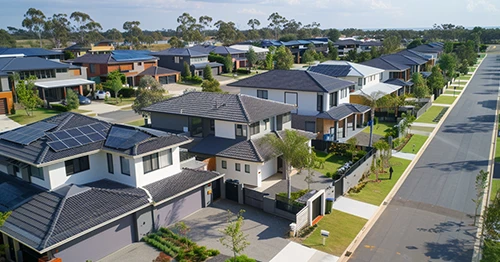Updated: 26 Dec, 2024
The Australian housing market showed signs of improvement in February 2024, as housing values experienced a subtle re-acceleration. CoreLogic’s national Home Value Index (HVI) for February 2024 increased by 0.6%, marking the strongest monthly gain since October 2023.
Except for Hobart, where the market fell by 0.3%, all capital cities and rest-of-state regions recorded a lift in housing values.
Here’s the report in full.
Resilient Housing Values
Despite high interest rates and cost-of-living pressures, housing values have remained resilient. Tim Lawless, CoreLogic’s research director, said this ongoing rise in housing values can be attributed to the persistent imbalance between supply and demand, which varies across cities and regions.
Standout Regions With High Capital Growth Rates
Perth continues to stand out, with a substantially higher rate of growth than other regions, experiencing a 1.8% increase in housing values over the month. Adelaide, Brisbane, and the regional areas of South Australia, Western Australia, and Queensland also demonstrate consistently high capital growth rates month to month. These regions benefitted from lower housing prices and positive demographic factors that support housing demand.
Sydney And Melbourne Show Signs of Improvement
While growth rates in Sydney and Melbourne’s home values levelled out, there was a monthly acceleration in the trend. Melbourne, which had experienced a three-month slump of negative monthly movements, recorded a subtle 0.1% rise in February. Similarly, Sydney’s dwelling values have returned to positive territory over the past two months, after a subtle decline in November and December.
Boost In Housing Confidence
The re-acceleration in value growth was accompanied by a bounce back in auction clearance rates and a rise in consumer sentiment. Auction clearance rates averaged in the high 60% range throughout February, indicating a better alignment between buyer and seller pricing expectations. The rise in sentiment suggests that households will be better able to make property purchase decisions.
Housing Turnover And Market Conditions
Housing turnover tracked higher than in the previous year but was slightly below the previous five-year average. Estimated dwelling sales over the three months ending in February was 4.7% above last year; in capital cities, sales tracked 6% higher than a year ago. Home sales volume may pick up later in the year if sentiment improves.
Market conditions have become increasingly diverse, with the Western Australia housing market showing an affordability advantage and strong demand, while Hobart’s housing market has experienced flat to falling values.
Rental Market Re-Acceleration
Rental values have also experienced a re-acceleration in early 2024. The monthly pace of change rose to 0.9% in February, the highest reading since March 2023. This increase was driven by the detached housing sector, with annual growth in house rents trending higher since October 2023. However, the trend in unit rents is easing, indicating a potential slowdown in the unit sector.
Rental Market and Gross Rental Yields
There was a pick up in the annual growth trend for rents to 8.5% over the 12 months ending in February. As mentioned above, this pick-up in rents has been particularly strong in the detached housing sector. Lawless noted that worsening affordability pressure could have slowed the pace of unit rental growth. Unit rents have surged 24.1% higher over the past two years, compared with a 16.6% increase in house rents.
Gross rental yields held reasonably firm across most markets and at 3.7% nationally, with rental rates rising faster than dwelling values since November 2023.
Outlook for Housing Values
The outlook for housing values has improved slightly, with a subtle re-acceleration in value gains observed in the year’s first two months. Various indicators, including a rise in consumer sentiment, lower inflation, and expectations of interest-rate cuts, suggest a positive shift in market conditions.
However, factors such as affordability constraints, rising unemployment, a slowdown in household savings, and a cautious lending environment will probably limit value growth in the near term.




